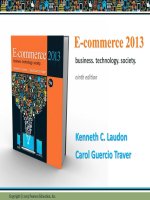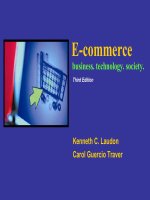Lecture E-commerce 2013: Business, technology, society (9/e): Chapter 6 - Kenneth C. Laudon, Carol Guercio Traver
Bạn đang xem bản rút gọn của tài liệu. Xem và tải ngay bản đầy đủ của tài liệu tại đây (2.06 MB, 55 trang )
E-commerce 2013
business. technology. society.
ninth edition
Kenneth C. Laudon
Carol Guercio Traver
Chapter 6
E-commerce Marketing Concepts: Social,
Mobile, Local
Copyright © 2013 Pearson Education, Inc.
Class Discussion
Facebook: Does Social Marketing Work?
Have you ever made a purchase based on
something you have read or seen on
Facebook? What was the product and what
made you interested?
What obstacles does Facebook face in
monetizing itself as a marketing and
advertising platform?
Are there other ways for Facebook to make a
profit from marketers and advertisers?
Copyright © 2013 Pearson Education, Inc.
Slide 6-3
Consumers Online: The Internet
Audience and Consumer Behavior
Around 75% (89 million) U.S. households have
Internet access in 2012
Growth rate has slowed
Intensity and scope of use both increasing
Some demographic groups have much higher
percentages of online usage than others
Gender, age, ethnicity, community type, income,
education
Copyright © 2013 Pearson Education, Inc.
Slide 6-4
Consumers Online (cont.)
Broadband vs. dial-up audiences, new mobile
audience
Neighborhood effects
Lifestyle and sociological impacts
Use of Internet by children, teens
Use of Internet as substitute for other social activities
Media choices
Traditional media competes with Internet for attention
Television viewing has increased with Internet usage
Copyright © 2013 Pearson Education, Inc.
Slide 6-5
Consumer Behavior Models
Study of consumer behavior
Attempts to explain what consumers purchase
and where, when, how much, and why they buy
Consumer behavior models
Predict wide range of consumer decisions
Based on background demographic factors and
other intervening, more immediate variables
Copyright © 2013 Pearson Education, Inc.
Slide 6-6
A General Model of Consumer Behavior
Figure 6.1, Page 348
Copyright © 2013 Pearson Education, Inc.
SOURCE: Adapted from Kotler and Armstrong, 2009.
Slide 6-7
Background Demographic Factors
Culture: Affects entire nations
Subculture
Subsets formed around major social differences
(ethnicity, age, lifestyle, geography)
Social networks and communities
Direct reference groups
Indirect reference groups
Opinion leaders
Lifestyle groups
Psychological profile
Copyright © 2013 Pearson Education, Inc.
Slide 6-8
The Online Purchasing Decision
Psychographic research
Combines demographic and psychological data
Divides market into various groups based on social
class, lifestyle, and/or personality characteristics
Stages in consumer decision process:
Awareness of need
Search for more information
Evaluation of alternatives
Actual purchase decision
Post-purchase contact with firm
Copyright © 2013 Pearson Education, Inc.
Slide 6-9
The Consumer Decision Process and
Supporting Communications
Figure 6.2, Page 352
Copyright © 2013 Pearson Education, Inc.
Slide 6-10
A Model of Online
Consumer Behavior
Decision process similar for online and offline
behavior
General online behavior model
Consumer skills
Product characteristics
Attitudes toward online purchasing
Perceptions about control over Web environment
Web site features: latency, usability, security
Clickstream behavior
Copyright © 2013 Pearson Education, Inc.
Slide 6-11
A Model of Online Consumer Behavior
Figure 6.3, Page 353
Copyright © 2013 Pearson Education, Inc.
Slide 6-12
A Model of Online Consumer Behavior (cont.)
Clickstream factors include:
Number of days since last visit
Speed of clickstream behavior
Number of products viewed during last visit
Number of pages viewed
Supplying personal information
Number of days since last purchase
Number of past purchases
Clickstream marketing
Developed dynamically as customers use Internet
Copyright © 2013 Pearson Education, Inc.
Slide 6-13
Shoppers: Browsers and Buyers
Shoppers: 88% of Internet users
72% buyers
16% browsers (purchase offline)
One-third of offline retail purchases influenced by
online activities
Online traffic also influenced by offline brands
and shopping
E-commerce and traditional commerce are
coupled: Part of a continuum of consuming
behavior
Copyright © 2013 Pearson Education, Inc.
Slide 6-14
What Consumers Shop for and
Buy Online
Big ticket items
Travel, computer hardware, electronics
Consumers now more confident in purchasing
costlier items
Small ticket items ($100 or less)
Apparel, books, office supplies, software, etc.
Sold by first movers on Web
Physically small items
High margin items
Copyright © 2013 Pearson Education, Inc.
Slide 6-15
How Consumers Shop
How shoppers find online vendors
Search engines—59%
Marketplaces (Amazon, eBay)—28%
Direct to retail sites—10%
Other methods—3%
Online shoppers are highly intentional
StumbleUpon
Recommender systems
Copyright © 2013 Pearson Education, Inc.
Slide 6-16
Trust, Utility, and Opportunism
in Online Markets
Two most important factors shaping
decision to purchase online:
Utility:
Better prices, convenience, speed
Trust:
Asymmetry of information can lead to opportunistic
behavior by sellers
Sellers can develop trust by building strong
reputations for honesty, fairness, delivery
Copyright © 2013 Pearson Education, Inc.
Slide 6-17
Basic Marketing Concepts
Marketing
Strategies and actions to establish relationship
with consumer and encourage purchases
Addresses competitive situation of industries
and firms
Seeks to create unique, highly differentiated
products or services that are produced or
supplied by one trusted firm
Unmatchable feature set
Avoidance of becoming commodity
Copyright © 2013 Pearson Education, Inc.
Slide 6-18
The Digital Commerce
Marketing Platform
Multi-channel marketing plan
Web site
Traditional online marketing
Search engine, display, e-mail, affiliate
Social marketing
Social networks, blogs, video, game
Mobile marketing
Mobile/tablet sites, apps
Offline marketing
Television, radio, newspapers
Copyright © 2013 Pearson Education, Inc.
Slide 6-19
Strategic Issues and Questions
Which part of the marketing plan should
you focus on first?
How do you integrate the different
platforms for a coherent message?
How do you allocate resources?
How do you measure and compare metrics from
different platforms?
How do you link each to sales revenues?
Copyright © 2013 Pearson Education, Inc.
Slide 6-20
Can Brands Survive the Internet?
Brands and Price Dispersion
Vision: “Law of One Price, ”end of brands
Instead:
Consumers still pay premium prices for differentiated
products
E-commerce firms rely heavily on brands to attract
customers and charge premium prices
Price dispersion
Large differences in price sensitivity for same product
“Library effect”
Copyright © 2013 Pearson Education, Inc.
Slide 6-21
Online Segmenting, Targeting, and
Positioning
Segmenting: Allows firms to differentiate products
to fit consumer needs and charge different prices
Types of segmentation
Behavioral
Demographic
Psychographic
Technical
Contextual
Search
Copyright © 2013 Pearson Education, Inc.
Slide 6-22
The Digital Commerce Marketing
Platform: Strategies and Tools
Internet marketing (vs. traditional)
More personalized
More participatory
More peer-to-peer
More communal
The most effective Internet marketing
has all four features
Copyright © 2013 Pearson Education, Inc.
Slide 6-23
Customer Engagement
Customer conversations about:
Products and services
Customer experience with products
Customer likes and dislikes
Conversations conducted through:
Web site feedback
Blogs
Copyright © 2013 Pearson Education, Inc.
Slide 6-24
Generic Market Entry Strategies
Figure 6-11, Page 391
Copyright © 2013 Pearson Education, Inc.
Slide 6-25









